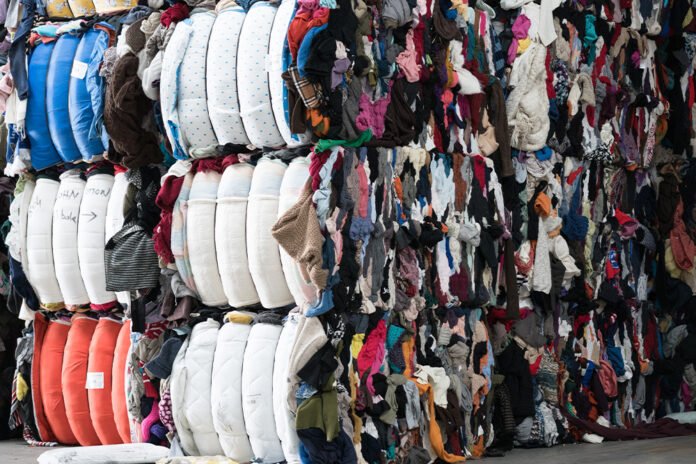GRI to create apparel sustainability reporting standards Biofibers! Are these the alternatives? Hurdles in switching to sustainable energy in Pakistan’s textile sector!
According to a European Environment Agency (EEA) briefing published this week, the amount of used textiles exported from the European Union (EU) has tripled over the past two decades, and the amounts may increase further. The report states that Europe faces major challenges in managing used textiles, which will be collected separately in the EU by 2025. As reuse and recycling capacities in Europe are limited, many discarded and donated clothing and other textile products are exported to Africa and Asia. Common public perceptions that used clothing donations are always used in those regions do not reflect reality. Once exported, the fate of used textiles is often uncertain, according to the EEA briefing, which looks at the patterns of and trends in EU exports of used textiles from 2000 to 2019.
Bio-based fibers used in clothing and other textile products are often regarded as more sustainable alternatives, but a new technical report by the EEA’s European Topic Centre of Circular Economy and Resource Use demonstrates that this picture requires some caution. While bio-based fibers offer the potential to steer away from synthetic textiles made from plastics (mainly derived from oil and gas), they cause other environmental pressures, including water and land use related to agricultural activities, deforestation, and fiber processing. Moreover, the report highlights that their bio-based origin does not free them from environmental concerns related to microfibres, waste, and recyclability.
The Global Reporting Initiative (GRI) is to create a sustainability reporting standard for the apparel and textile sector to enhance reporting by brands and manufacturers. GRI has announced a global call for applicants to join the Textiles and Apparel Working Group, including representatives from business enterprises, investors, labor bodies, mediating institutions, and civil society. The Textiles and Apparel Sector Standard will apply to any organization primarily focusing on textile and apparel production, including manufacturing activities, brands, retailers, and wholesalers. The GRI Standard will promote full and enhanced transparency to allow comparability of sustainability information by setting a global disclosure framework for the sector.
The energy sector is the largest GHG producer in Pakistan, and it is estimated that the energy demand in the country will reach 108 – 126 million tons of oil equivalent (TOE) by 2030. With the growing unsustainable management of energy demand, Pakistan’s continuous reliance on imported fossil fuels and outdated coal technology has affected the country’s energy security and compliance with global energy efficiency and decarbonization requirements. The answer to the above is renewable energy. Pakistan has tremendous potential to fulfill its growing energy demand from renewables, including solar, wind, hydro, geothermal, and Biomass, as these resources are greatly available in the country.
Solar, for instance, is the most attractive alternate energy solution, which has received considerable attention recently. Pakistan’s southwest region receives the highest irradiation, and Biomass is estimated to generate 50,000 Gwh/year. Finally, geothermal energy resources are present in all the provinces, which can be used for power generation, heating and cooling buildings, and hot water supply. If Pakistan brings into play this untapped potential in all the major sectors by implementing good policy reforms in spirit and expanding RE, a massive decoupling of growth from conventional energy resources such as fossil fuels can add to the existing efforts on climate resilience. The analysis of the current scenario of industrial energy efficiency reveals that the share of alternate energy sources, such as renewable electricity and Biomass, in the industry is limited. Technology such as motors and boilers are inefficient and innovative ideas to save energy are exercised inadequately. However, government support is limited, and the hurdles are bigger than expected.
Further this week, a new European Union (EU) project network has been launched to accelerate collaboration in textile sustainability. COSYSTEX (European Community of Practice for a Sustainable Textile Ecosystem) is a joint sustainability initiative of the European Commission’s Research Executive Agency (REA), the European Health and Digital Executive Agency (HaDEA) and the Circular-Biobased Europe Joint Undertaking, and is facilitated by the Textile ETP. It comprises 17 R&I EU-funded member projects focusing on textile sustainability, aiming to accelerate collaboration in the textile sustainability and circularity field.
Further this week, Saeed Ahmed Awan Center for Improvement of Working Conditions and Environment (SAA-CIWCE), with the support of GIZ Pakistan, has initiated a social and behavior change communication campaign to promote the health and safety culture in the textile industry of Pakistan, i.e, promoting sustainable and ethical manufacturing. The targeted campaign includes stakeholders of the Ministry of Commerce, the government of Pakistan, the Labour and Human Resource Department, the government of Punjab, and other notable public and private organizations working to support improving health and safety standards in the textile industry of Pakistan.
Further this week, Saudi Arabia’s MODON has seen textile investments of SR4.1bn ($1.1bn). The volume of industrial investments in textiles and fabrics within the scope of MODON is expected to exceed SR4.1bn. These investments are distributed over 125 industrial contracts in 19 industrial cities, covering over one million square meters. One thing that has been considered for this big investment is sustainable manufacturing. The Kingdom of Saudi Arabia as well as the MODON, are keen to setting an example to the world for sustainable practices in textile production.
Further, this week, PatPat, a leading children’s apparel e-commerce brand, launched a new line of baby clothing made with sustainable Eastman Naia™ cellulosic fiber, which is OEKO-TEX® Standard 100 certified. The new PatPat-Naia™Baby Collection is high quality and has a low environmental impact, making it gentle on babies’ skin and the environment. PatPat is investing further in sustainability to reduce its impact on the planet and create a better future for children starting with the clothes they wear daily.



